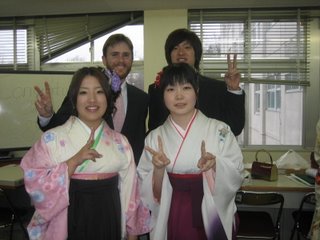
Last week I went to the same junior high school I went to last month for a demonstration lesson in front of 30 English teachers and officials of the city I was visiting. I was asked to teach page 60(?) of the New Horizon Textbook. My students were 35 third graders (9th grade). I was supposed to teach the nominative use of that relative clauses (The word being modified is the subject of the that clause, in Japanese this is 主格のthat). For example,
- This is the dog that ate the cat.
- The country that hosted the world cup was Germany.
I was not supposed to teach the objective use of that relative clauses (The word being modified is the object of the that relative clause, 目的格のthat).
The above explanation makes the class sound more difficult than it actually was. This class went better than the last one because I decided to flood students with input and encourage them to learn the new grammatical pattern that way rather than force them to speak a grammatical pattern that they did not need to use so much. I also had a graduate student, John Wang, and an undergraduate student, Monchichi, come and help me by joining the various students groups during the activity and providing support. Here is what we did:
Goal:
- Use jeopardy to help students learn how to use "nominative that relative pronoun clauses" through input flooding
- Do 95% of the class in English
- The students experience group work and speak English within the group
Class:
Warm up (Materials: computer, projector)
Plan: Students make pairs. Using MS powerpoint, I display 10 questions. One member of a pair is looking at the screen and asking questions to the other member who is turned away from the screen and cannot see the questions. Then, the members switch.
What happened: Students were nervous at first but did this activity.
Introduce the Key Sentence: (Materials: sentence cards (made by some nice graduate students) to put on the blackboard)
What I did and how the students reacted:
I put the following two sentences in the blackboard:
1. Mr Hall is an Iwate University teacher.
2. He is nice.
I asked students to make the two sentences into one sentence. Most of the students knew how to do this but no one volunteered an answer as I had anticipated so I simply reminded students that the sentence would be:
Mr Hall is an Iwate University teacher who is nice.
I asked students, "Why do we use 'who'?" Of course I had no answer so I asked a student, "Is Mr. Hall an animal?" The student, after an initial period of uncomfortable silence said "no." I then asked is "Mr. Hall a thing?" and asked a student for an answer. Unfortunately the student answer, "yes". I then said that I was not a "thing" but a "human" and that we use "who" to add information about humans. (The students had studied "who".)
Next, I then put the following two sentence cards on the board:
1. Kobe is a city.
2. It has great beef.
I then combined these two sentences to make
Kobe is a city that has great beef.
I asked students if Kobe was a human to which they replied "no." I then told them that we used "that" to add information about "things" or "non-humans" and asked them to make a sentence out of the following two sentences:
1. The Nile is a river.
2. It is in Africa.
As a class, students made the sentence
The Nile is a river that is in Africa.
I did not call on a student because I knew that no students would answer in such an atmosphere where they were being taight by someone they did not know and were being watched by 30 or so other strangers. Nevertheless, students seemed to understand so we went to the next activity.
Jeopardy (Trivia) (Materials: computer, projector, name tags)
Preparation:Before we started jeopardy, students made groups. The groups were pre-determined by the homeroom teacher. Each group had 6 people and each person in the group was assigned a letter from A - F.
(Side note: ALTs who teach the same students only once a month, if you are going to do group work (more than 2 members per team) I recommend that you have the HRT determine the groups in advance and tell the students before the class they will do group work. The homeroom teachers knows best which students work best together and how to make the groups about even in ability.)
Students also wore nametags. Before class, students wrote the name they wanted to be called, their group number, and their letter(A-F). The nametag looked something like this:
Group 4 Letter E Jimbo |
The Game
How it was played: I explained that "that" and "who" sentences could be used for trivia and then demonstrated (not explained) how to play jeopardy by practicing a few questions. I told students that jeopardy meant 質問コーナー in Japanese. The rules were that each group would have one leader and that only the leader could answer the question. Of course, the other group members could tell the leader the answer but only the leader could raise his hand. However, the leader would change after every question. For the first question, the leader was student A from each group. After the question, the leader changed. I used powerpoint to display the jeopardy game and questions. The jeopardy template came from EFL Geek and I added the questions. The file that we used to play jeopardy can be downloaded here.
Each question and answer had a nominative "who" or "that" relative clause sentence. When a group answers a question correctly, they were able to rest. The other groups would have to repeat the answer which had the target structure. After they repeated the answer, I would remove the target structure and students would have to repeat the sentence without the target structure.
Ex.
Question: This is a man from Iwate who played on the Japanese Soccer Team.
Answer: The man who played on the Japanese Soccer Team is Mitsuo Ogasawara. (All the groups except the group that answered correctly repeats.)
Answer without target structure: The man is ^^^^ Mitsu Ogasawara. (Students say the sentence adding the omitted target structure).
How the students reacted: On their evaluation forms, most students said that they understood the "that" construction and they enjoyed the class. Many also said that they had made the effort to speak English in their groups. I owe that to John and Monchichi who worked with each group and helped motivate them to speak English.
During the game, students struggled to repeat the sentence without the target structure.
I have learned a lot from my last 3 experiences teaching at a junior high school and senior high school. I am finally understanding the students and what they will or will not do in the classroom. This is good because the next time I teach jr high students I can have a class with activities I know that they can do so that the students remain confident and feel secure but also mix these secure activities with more demanding ones that will force students to challenge themselves without overwhelming them.
I also understand what kind of groundwork has to be done in advance for the students to be able to do group work (This is only if you are a visiting teacher and will only teach the students a few times a year.).








 On March 26, I gave a workshop titled "How can we succeed in teaching English in jr. and sr. high schools?". The workshop was sponsored by Iwate JALT and the Iwate University Faculty of Education. Althogether there were 20 people including me. The participants consisted of 6 American(to my knowledge) teachers, 2 teachers and research fellows from the Philippines, 2 graduate students from China, 7 Japanese university students (most of them had experience teaching), a translator, a Japanese teacher of English, and a Japanese Univeristy Professor. It was an excellent mix of people from different backgrounds and the number of participants was just right.
On March 26, I gave a workshop titled "How can we succeed in teaching English in jr. and sr. high schools?". The workshop was sponsored by Iwate JALT and the Iwate University Faculty of Education. Althogether there were 20 people including me. The participants consisted of 6 American(to my knowledge) teachers, 2 teachers and research fellows from the Philippines, 2 graduate students from China, 7 Japanese university students (most of them had experience teaching), a translator, a Japanese teacher of English, and a Japanese Univeristy Professor. It was an excellent mix of people from different backgrounds and the number of participants was just right.


